Block or Connect? Optimizing Ecological Corridors to Enhance the Dual Functions of Resistance and Provision in Forest-Mountain Ecological Security Barriers
Abstract
1. Introduction
2. Materials
2.1. Study Area
2.2. Data Sources
3. Research Framework and Methods
3.1. Resistance: Breaking Up Risk Corridors
3.1.1. Wind Source Identification
3.1.2. Wind Resistance Surface Construction
3.1.3. Blocking Risk Corridors
3.2. Supply: Support for Protected Areas
3.2.1. Ecosystem Services Calculation Methods
3.2.2. Comprehensive Evaluation of Ecosystem Service Supply and Demand
3.2.3. Resistance Surface Construction
3.2.4. Connecting Supply Corridors
4. Result
4.1. Identification and Mitigation of Risk Corridors
4.1.1. Identification of Risk Corridors
4.1.2. Analysis of the Mechanism of Key Nodes in Risk Corridors
4.2. Identification and Consolidation of Supply Corridors
4.2.1. Supply Ecological Network Identification
4.2.2. Analysis of the Mechanism of Key Nodes in Supply Corridors
5. Discussion
5.1. The Applicability of Methods for Optimizing Ecological Corridors to Enhance the Dual Functions of Forest-Mountain Areas as Ecological Barriers
5.2. Policy Implications for Blocking Risk Corridors and Connecting Supply Corridors
5.3. Research Limitations and Future Directions
6. Conclusions
Supplementary Materials
Author Contributions
Funding
Data Availability Statement
Conflicts of Interest
Abbreviations
- The following abbreviations are used in this manuscript:
| WC | water conservation |
| CS | carbon sequestration |
| AP | air purification |
| UC | urban cooling |
| EVA | mean annual evapotranspiration |
| VWC | soil volumetric water content |
| MAP | mean annual precipitation |
| TEM | land surface temperature |
| WSD | wend speed |
| HFP | human footprint index |
| NDVI | normalized difference vegetation index |
| DEM | digital elevation model |
| SLO | slope |
| XGBoost | eXtreme gradient boosting |
| SHAP | SHapley additive exPlanations |
References
- Cai, E.X.; Zhang, S.N.; Chen, W.Q.; Li, L. Spatio-temporal dynamics and human-land synergistic relationship of urban expansion in Chinese megacities. Heliyon 2023, 9, 12. [Google Scholar] [CrossRef]
- He, J.J.; Huang, Z.R.; Fan, X.; Zhang, H.; Zhou, R.; Song, M.W. The impact of environmental regulation on regional economic growth: A case study of the Yangtze River Economic Belt, China. PLoS ONE 2023, 18, e0290607. [Google Scholar] [CrossRef] [PubMed]
- Niu, H.P.; Liu, M.M.; Xiao, D.Y.; Zhao, X.M.; An, R.; Fan, L.X. Spatio-Temporal Characteristics of Trade-Offs and Synergies in Ecosystem Services at Watershed and Landscape Scales: A Case Analysis of the Yellow River Basin (Henan Section). Int. J. Environ. Res. Public Health 2022, 19, 15772. [Google Scholar] [CrossRef] [PubMed]
- Li, C.; Wu, Y.M.; Gao, B.P.; Zheng, K.J.; Wu, Y.; Wang, M.J. Construction of ecological security pattern of national ecological barriers for ecosystem health maintenance. Ecol. Indic. 2023, 146, 17. [Google Scholar] [CrossRef]
- Tang, L.D.; Liang, G.D.; Gu, G.H.; Xu, J.; Duan, L.; Zhang, X.Y.; Yang, X.X.; Lu, R.C. Study on the spatial-temporal evolution characteristics, patterns, and driving mechanisms of ecological environment of the Ecological Security Barriers on China’s Land Borders. Environ. Impact Assess. Rev. 2023, 103, 18. [Google Scholar] [CrossRef]
- Tang, L.; Long, H.; Aldrich, D.P. Putting a Price on Nature: Ecosystem Service Value and Ecological Risk in the Dongting Lake Area, China. Int. J. Environ. Res. Public Health 2023, 20, 4649. [Google Scholar] [CrossRef]
- Bai, J.T.; Sun, R.; Liu, Y.F.; Chen, J.; Li, X.H. Integrating ecological and recreational functions to optimize ecological security pattern in Fuzhou City. Sci. Rep. 2025, 15, 22. [Google Scholar] [CrossRef]
- Yu, J.-F.; Du, H.-Y.; Wang, J.-L.; Zhang, Y. Construction and Assessment of Ecological Security Pattern in Gansu Along the Yellow River Based on Zonation-MSPA Coupling Model. Huan Jing Ke Xue Huanjing Kexue 2025, 46, 3085–3097. [Google Scholar]
- Wang, X.X.; Wang, X.F.; Zhang, X.R.; Zhou, J.T.; Jia, Z.X.; Ma, J.H.; Yao, W.J.; Tu, Y.; Sun, Z.C.; Wei, Y.H. Ecological barriers: An approach to ecological conservation and restoration in China. Ambio 2024, 53, 1077–1091. [Google Scholar] [CrossRef]
- Xu, D.M.; Peng, J.; Jiang, H.; Dong, J.Q.; Liu, M.L.; Chen, Y.Y.; Wu, J.S.; Meersmans, J. Incorporating barriers restoration and stepping stones establishment to enhance the connectivity of watershed ecological security patterns. Appl. Geogr. 2024, 170, 10. [Google Scholar] [CrossRef]
- Mu, H.W.; Li, X.C.; Ma, H.J.; Du, X.P.; Huang, J.X.; Su, W.; Yu, Z.; Xu, C.; Liu, H.L.; Yin, D.Q.; et al. Evaluation of the policy-driven ecological network in the Three-North Shelterbelt region of China. Landsc. Urban. Plan. 2022, 218, 11. [Google Scholar] [CrossRef]
- Iungman, T.; Caballé, S.V.; Segura-Barrero, R.; Cirach, M.; Mueller, N.; Daher, C.; Villalba, G.; Barboza, E.P.; Nieuwenhuijsen, M. Co-benefits of nature-based solutions: A health impact assessment of the Barcelona Green Corridor (Eixos Verds) plan. Environ. Int. 2025, 196, 13. [Google Scholar] [CrossRef] [PubMed]
- Wu, S.T.; Shi, S.; Zhang, J.L. Evolution Analysis of Ecological Security Pattern in Forest Areas Coupling Carbon Storage and Landscape Connectivity: A Case Study of the Xiaoxing’an Mountains, China. Forests 2025, 16, 331. [Google Scholar] [CrossRef]
- Huang, H.; Fu, D.L.; Ding, G.C.; Yan, C.; Xie, X.C.; Gao, Y.L.; Liu, Q.Y. Construction and optimization of Green Infrastructure Network in mountainous cities: A case study of Fuzhou, China. Sci. Rep. 2024, 14, 17. [Google Scholar] [CrossRef]
- Yu, Z.W.; Zhang, J.G.; Yang, G.Y. How to build a heat network to alleviate surface heat island effect? Sust. Cities Soc. 2021, 74, 10. [Google Scholar] [CrossRef]
- Li, W.J.; Kang, J.W.; Wang, Y. Exploring the interactions and driving factors among typical ecological risks based on ecosystem services: A case study in the Sichuan-Yunnan ecological barrier area. Ecol. Indic. 2025, 170, 14. [Google Scholar] [CrossRef]
- Liu, F.; Zhang, Q.; Wang, J.L.; Liu, Y.X.; Wang, W.B.; Li, S. Ecological security assessment of Yunnan Province, China in the context of Production-Living-Ecological space division. Ecol. Evol. 2024, 14, 18. [Google Scholar] [CrossRef]
- Ren, J.Y.; Wang, W.J.; Fei, L.; Wang, L.; Xing, S.F.; Cong, Y. Impacts of climate change and land Use/Cover change on ecological security networks in Changbai Mountains, Northeast China. Ecol. Indic. 2024, 169, 10. [Google Scholar] [CrossRef]
- Wang, S.; Zhang, R.; Wang, J.F.; Li, Q.; Wang, R.D.; Li, Y.R.; Zhang, L.X. Identification and optimization of ecological corridors in the middle reaches of the Yellow River Basin. J. Clean. Prod. 2025, 512, 12. [Google Scholar] [CrossRef]
- Li, C.; Wu, Y.M.; Gao, B.P.; Zheng, K.J.; Wu, Y.; Li, C. Multi-scenario simulation of ecosystem service value for optimization of land use in the Sichuan-Yunnan ecological barrier, China. Ecol. Indic. 2021, 132, 13. [Google Scholar] [CrossRef]
- Yang, D.; Gao, Y.; Chen, J.; Li, X.; Li, Z.; Shen, L.; Yang, C. Optimizing regional ecological security patterns based on interpretable machine learning models: A case study of Huzhou, Zhejiang Province. J. Environ. Manag. 2025, 393, 126905. [Google Scholar] [CrossRef]
- Gou, R.; Su, W.-C.; Huang, X.-F. Construction of Ecological Security Network and Multi-scenario Simulation in Guizhou Province Based on Landscape Ecological Security Assessment. Huan Jing Ke Xue Huanjing Kexue 2025, 46, 4580–4591. [Google Scholar] [PubMed]
- Zhang, H.X.; Song, Q.; Wang, S.R.; Zhao, J.Y.; Gao, W.M. Ecological network construction and land degradation risk identification in the Yellow River source area. iScience 2025, 28, 16. [Google Scholar] [CrossRef]
- Wang, Z.Y.; Zhang, J.; Chen, J.C.; Gao, H.Z.; Li, J.M.; Li, M.H. Determining the ecological security pattern and important ecological regions based on the supply-demand of ecosystem services: A case study of Xuzhou City, China. Front. Public Health 2023, 11, 14. [Google Scholar] [CrossRef]
- Sharma, D.; Das, S.; Goswami, B.N. Variability and predictability of the Northeast India summer monsoon rainfall. Int. J. Climatol. 2023, 43, 5248–5268. [Google Scholar] [CrossRef]
- Shi, Y.; Fan, Q.; Song, X.A.; Li, D.D. Assessing the severity of urban heat transfer and flow across years: Evidence from thermal environment spatial networks. Urban. Clim. 2025, 61, 14. [Google Scholar] [CrossRef]
- Yang, J. Economic Synergistic Development of Guangdong-Hong Kong-Macao Greater Bay Area Urban Agglomeration: Based on Composite System. Comput. Intell. Neurosci. 2022, 2022, 10. [Google Scholar] [CrossRef]
- Liu, Y. Coupling and coordination evaluation of digital economy and green development efficiency in eight urban agglomerations in China. Sci. Rep. 2025, 15, 17. [Google Scholar] [CrossRef]
- An, P.F.; Li, C.; Duan, Y.J.; Ge, J.F.; Feng, X.M. Inter-metropolitan land price characteristics and pattern in the Beijing-Tianjin-Hebei urban agglomeration, China. PLoS ONE 2021, 16, e0256710. [Google Scholar] [CrossRef] [PubMed]
- Wang, X.F.; Xu, S.L.; Huang, X.; Yang, C.C.; Li, Y.S. Optimization and Construction of Forestland Ecological Security Pattern: A Case Study of the Huai River Source-Dabie Mountains in China. Forests 2025, 16, 426. [Google Scholar] [CrossRef]
- Xiao, Q.; Xiao, Y.; Luo, Y.; Song, C.S.; Bi, J.C. Effects of afforestation on water resource variations in the Inner Mongolian Plateau. PeerJ 2019, 7, 16. [Google Scholar] [CrossRef]
- Chen, J.H.; Wang, D.C.; Li, G.D.; Sun, Z.C.; Wang, X.; Zhang, X.; Zhang, W. Spatial and Temporal Heterogeneity Analysis of Water Conservation in Beijing-Tianjin-Hebei Urban Agglomeration Based on the Geodetector and Spatial Elastic Coefficient Trajectory Models. GeoHealth 2020, 4, 18. [Google Scholar] [CrossRef]
- Fang, J.Z.; Xiong, K.N.; Chi, Y.K.; Song, S.Z.; He, C.; He, S.Y. Research Advancement in Grassland Ecosystem Vulnerability and Ecological Resilience and Its Inspiration for Improving Grassland Ecosystem Services in the Karst Desertification Control. Plants 2022, 11, 1290. [Google Scholar] [CrossRef]
- Yan, F.; Guo, X.Y.; Zhang, Y.W.; Shan, J.; Miao, Z.H.; Li, C.Y.; Huang, X.H.; Pang, J.; Chen, Y.H. Analysis of the multiple drivers of vegetation cover evolution in the Taihangshan-Yanshan region. Sci. Rep. 2024, 14, 21. [Google Scholar] [CrossRef] [PubMed]
- Zhao, S.M.; Zhang, Z.X.; Gao, C.Y.; Dong, Y.D.; Jing, Z.Y.; Du, L.X.; Hou, X.Y. MaxEnt-Based Predictions of Suitable Potential Distribution of Leymus secalinus Under Current and Future Climate Change. Plants 2025, 14, 293. [Google Scholar] [CrossRef] [PubMed]
- Wang, F.; Liu, J.; Fu, T.; Gao, H.; Qi, F. Spatial-Temporal Variations in of Soil Conservation Service and Its Influencing Factors under the Background of Ecological Engineering in the Taihang Mountain Area, China. Int. J. Environ. Res. Public Health 2023, 20, 3427. [Google Scholar] [CrossRef]
- Du, H.Q.; Zhao, L.; Zhang, P.T.; Li, J.X.; Yu, S. Ecological compensation in the Beijing-Tianjin-Hebei region based on ecosystem services flow. J. Environ. Manag. 2023, 331, 14. [Google Scholar] [CrossRef]
- Chen, Y.M.; Zhai, Y.P.; Gao, J.X. Spatial patterns in ecosystem services supply and demand in the Jing-Jin-Ji region, China. J. Clean. Prod. 2022, 361, 14. [Google Scholar] [CrossRef]
- Jiang, H.T.; Guo, C.R.; Li, X.J.; Zhang, W.F.; Du, P.F.; Guo, Q.K.; Wang, Y.S.; Wang, J. Assessing the contribution of wind and water erosion in the agro-pastoral ecotone of Northern China with 137Cs tracer technology. Sci. Rep. 2025, 15, 24. [Google Scholar] [CrossRef]
- Fang, Y.H.; Zhao, L.Y. Assessing the environmental benefits of urban ventilation corridors: A case study in Hefei, China. Build. Environ. 2022, 212, 13. [Google Scholar] [CrossRef]
- Wang, Y.Y.; Xiao, Y.; Xie, G.D.; Xu, J.; Qin, K.Y.; Liu, J.Y.; Niu, Y.N.; Gan, S.; Huang, M.D.; Zhen, L. Evaluation of Qinghai-Tibet Plateau Wind Erosion Prevention Service Based on RWEQ Model. Sustainability 2022, 14, 4635. [Google Scholar] [CrossRef]
- Huang, X.B.; Liu, X.S.; Jin, Y.H.; Gao, X.; Chen, Y.L. Identification and attribution analysis of integrated ecological zones based on the XGBoost-SHAP model: A case study of Chengdu, China. Ecol. Indic. 2025, 177, 18. [Google Scholar] [CrossRef]
- Schwantes, A.M.; Firkowski, C.R.; Gonzalez, A.; Fortin, M.J. Revealing driver-mediated indirect interactions between ecosystem services using Bayesian Belief Networks. Ecosyst. Serv. 2025, 73, 12. [Google Scholar] [CrossRef]
- Wang, Q.Y.; Zhao, Q.J. Assessing Ecological Infrastructure Investments-A Case Study of Water Rights Trading in Lu’an City, Anhui Province, China. Int. J. Environ. Res. Public Health 2022, 19, 2443. [Google Scholar] [CrossRef]
- Wang, L.; Huang, L.; Cao, W.; Zhai, J.; Fan, J.W. Assessing grassland cultural ecosystem services supply and demand for promoting the sustainable realization of grassland cultural values. Sci. Total Environ. 2024, 912, 13. [Google Scholar] [CrossRef]
- Zhang, Y.L.; Su, T.T.; Ma, Y.; Wang, Y.Y.N.; Wang, W.Q.; Zha, N.Y.; Shao, M. Forest ecosystem service functions and their associations with landscape patterns in Renqiu City. PLoS ONE 2022, 17, e0265015. [Google Scholar] [CrossRef] [PubMed]
- Gao, M.W.; Hu, Y.C.; Liu, X.W.; Liang, M.Y. Revealing multi-scale characteristics of ecosystem services supply and demand imbalance to enhance refined ecosystem management in China. Ecol. Indic. 2025, 170, 13. [Google Scholar] [CrossRef]
- Luo, C.; Li, X.Y. Assessment of Ecosystem Service Supply, Demand, and Balance of Urban Green Spaces in a Typical Mountainous City: A Case Study on Chongqing, China. Int. J. Environ. Res. Public Health 2021, 18, 11002. [Google Scholar] [CrossRef]
- Wang, D.M.; Hu, Y.G.; Tang, P.X.; Liu, C.; Kong, W.H.; Jiao, J.; Kovács, K.F.; Kong, D.Z.; Lei, Y.K.; Liu, Y.P. Identification of Priority Implementation Areas and Configuration Types for Green Infrastructure Based on Ecosystem Service Demands in Metropolitan City. Int. J. Environ. Res. Public Health 2022, 19, 8191. [Google Scholar] [CrossRef]
- Wang, Y.; Fu, Q.; Wang, T.H.; Gao, M.F.; Chen, J.H. Multiscale Characteristics and Drivers of the Bundles of Ecosystem Service Budgets in the Su-Xi-Chang Region, China. Int. J. Environ. Res. Public Health 2022, 19, 12910. [Google Scholar] [CrossRef]
- Wang, C.J.; Wan, J.Z.; Zhang, Z.X.; Zhang, G.M. Identifying appropriate protected areas for endangered fern species under climate change. SpringerPlus 2016, 5, 12. [Google Scholar] [CrossRef]
- Kreitler, J.; Schloss, C.A.; Soong, O.; Hannah, L.; Davis, F.W. Conservation Planning for Offsetting the Impacts of Development: A Case Study of Biodiversity and Renewable Energy in the Mojave Desert. PLoS ONE 2015, 10, e0140226. [Google Scholar] [CrossRef] [PubMed]
- Villa, F.; Bagstad, K.J.; Voigt, B.; Johnson, G.W.; Portela, R.; Honzák, M.; Batker, D. A Methodology for Adaptable and Robust Ecosystem Services Assessment. PLoS ONE 2014, 9, e91001. [Google Scholar] [CrossRef]
- Popescu, V.D.; Munshaw, R.G.; Shackelford, N.; Pouzols, F.M.; Dubman, E.; Gibeau, P.; Horne, M.; Moilanen, A.; Palen, W.J. Quantifying biodiversity trade-offs in the face of widespread renewable and unconventional energy development. Sci. Rep. 2020, 10, 12. [Google Scholar] [CrossRef] [PubMed]
- Wu, D.F.; Mo, J.Z.; Zeng, L.C.; Zhou, P.; Xie, M.Y.; Yuan, H.B. Ecosystem services scenario simulation in Guangzhou based on the FLUS-InVEST model. Sci. Rep. 2025, 15, 18. [Google Scholar] [CrossRef] [PubMed]
- Cao, W.J.; Jia, G.X.; Yang, Q.K.; Sun, H.Y.; Wang, L.X.; Svenning, J.C.; Wen, L. Construction of ecological network and its temporal and spatial evolution characteristics: A case study of Ulanqab. Ecol. Indic. 2024, 166, 10. [Google Scholar] [CrossRef]
- Sun, D.L.; Wu, X.Q.; Wen, H.J.; Ma, X.L.; Zhang, F.T.; Ji, Q.; Zhang, J.L. Ecological Security Pattern based on XGBoost-MCR model: A case study of the Three Gorges Reservoir Region. J. Clean. Prod. 2024, 470, 143252. [Google Scholar] [CrossRef]
- Fan, J.Y.; Liu, S.L.; Wang, W.T.; Li, Y.T.; Zhao, Y.F.; Wu, G. Quantifying the ecological network dynamics associated with ecological restoration projects: A case study in Southwest China. Glob. Ecol. Conserv. 2025, 62, 16. [Google Scholar] [CrossRef]
- Hu, L.H.; Xie, Y.M.; Liu, Y.Z.; Chen, S.Y.; Yu, H.F.; Bie, Q.L.; Zhao, F.; Zhao, Y.L. Mapping the primary factors driving spatiotemporal variations of surface soil moisture in the Yellow River Basin of China. Sci. Rep. 2025, 15, 17. [Google Scholar] [CrossRef]
- Chen, Y.; Liu, Y.L.; Yang, S.F.; Liu, C.W. Impact of Land-Use Change on Ecosystem Services in the Wuling Mountains from a Transport Development Perspective. Int. J. Environ. Res. Public Health 2023, 20, 1323. [Google Scholar] [CrossRef]
- Bandyopadhyay, S.; Maiti, S.K. Steering restoration of coal mining degraded ecosystem to achieve sustainable development goal-13 (climate action): United Nations decade of ecosystem restoration (2021–2030). Environ. Sci. Pollut. Res. 2022, 29, 88383–88409. [Google Scholar] [CrossRef]
- Shi, H.Q.; Zheng, F.L.; Zhao, T.; Xu, X.M.; Liu, G. Impacts of straw mulching in longitudinal furrows on hillslope soil erosion and deposition in the Chinese Mollisol region. Soil. Tillage Res. 2024, 243, 11. [Google Scholar] [CrossRef]
- Lintunen, A.; Preisler, Y.; Oz, I.; Yakir, D.; Vesala, T.; Hölttä, T. Bark Transpiration Rates Can Reach Needle Transpiration Rates Under Dry Conditions in a Semi-arid Forest. Front. Plant Sci. 2021, 12, 16. [Google Scholar] [CrossRef]
- Liu, R.; Wang, Y.X.; Zhang, Y.; Peng, Z.X.; Chen, H.K.; Li, X.; Li, H.; Li, W.Y. Analysis of the city-scale wind environment and detection of ventilation corridors in high-density metropolitan areas based on CFD method. Urban. Clim. 2025, 59, 14. [Google Scholar] [CrossRef]
- Tianjiao, F.; Mingxin, J.; Yixin, W.; Dong, W.; Zhiming, X.; Huijie, X.; Junran, L. Impact of farmland shelterbelt patterns on soil properties, nutrient storage, and ecosystem functions in desert oasis ecotones of Hetao irrigated areas, China. Catena 2023, 225, 14. [Google Scholar] [CrossRef]
- Yu, Z.W.; Chen, J.Q.; Chen, J.K.; Zhan, W.F.; Wang, C.H.; Ma, W.J.; Yao, X.H.; Zhou, S.Q.; Zhu, K.; Sun, R.H. Enhanced observations from an optimized soil-canopy-photosynthesis and energy flux model revealed evapotranspiration-shading cooling dynamics of urban vegetation during extreme heat. Remote Sens. Environ. 2024, 305, 15. [Google Scholar] [CrossRef]
- Zhang, M.R.; Xu, Y.; Wang, J.; Hu, J.Z.; Qi, S.T.; Jiang, Z.W.; Yang, S.H. Impact of biochar on the antibiotic resistome and associated microbial functions in rhizosphere and bulk soil in water-saving and flooding irrigated paddy fields. Environ. Pollut. 2024, 342, 12. [Google Scholar] [CrossRef]
- Adhikari, Y.; Bachstein, N.; Gohr, C.; Blumröder, J.S.; Meier, C.; Ibisch, P.L. Old-growth beech forests in Germany as cool islands in a warming landscape. Sci. Rep. 2024, 14, 14. [Google Scholar] [CrossRef]
- Wang, M.; Qin, K.T.; Jia, Y.H.; Yuan, X.H.; Yang, S.Q. Land Use Transition and Eco-Environmental Effects in Karst Mountain Area Based on Production-Living-Ecological Space: A Case Study of Longlin Multinational Autonomous County, Southwest China. Int. J. Environ. Res. Public Health 2022, 19, 7587. [Google Scholar] [CrossRef] [PubMed]
- Yi, X.B.; Wang, L. Land Suitability Assessment on a Watershed of Loess Plateau Using the Analytic Hierarchy Process. PLoS ONE 2013, 8, e69498. [Google Scholar] [CrossRef][Green Version]
- Li, G.; Yang, T.; Chen, R.; Dong, H.G.; Wu, F.; Zhan, Q.H.; Huang, J.Y.; Luo, M.X.; Wang, L. Experimental study on in-situ simulation of rainfall-induced soil erosion in forest lands converted to cash crop areas in Dabie Mountains. PLoS ONE 2025, 20, e0317889. [Google Scholar] [CrossRef] [PubMed]
- Yu, K.N.; Yang, C.J.; Wu, T.; Zhai, Y.F.; Tian, S.X.; Feng, Y.Q. Analysis of vegetation coverage changes and driving forces in the source region of the yellow river. Sci. Rep. 2025, 15, 17. [Google Scholar] [CrossRef] [PubMed]
- Li, G.C.; Chen, W.; Zhang, X.P.; Yang, Z.; Bi, P.S.; Wang, Z. Ecosystem Service Values in the Dongting Lake Eco-Economic Zone and the Synergistic Impact of Its Driving Factors. Int. J. Environ. Res. Public Health 2022, 19, 3121. [Google Scholar] [CrossRef]
- Hu, H.; Tao, Y.C.; Zhang, H.; Zhao, Y.Q.; Lan, Y.D.; Ge, Z.H. Experimental study on the influence of longitudinal slope on airflow-dust migration behavior after tunnel blasting. Sci. Rep. 2023, 13, 18. [Google Scholar] [CrossRef] [PubMed]
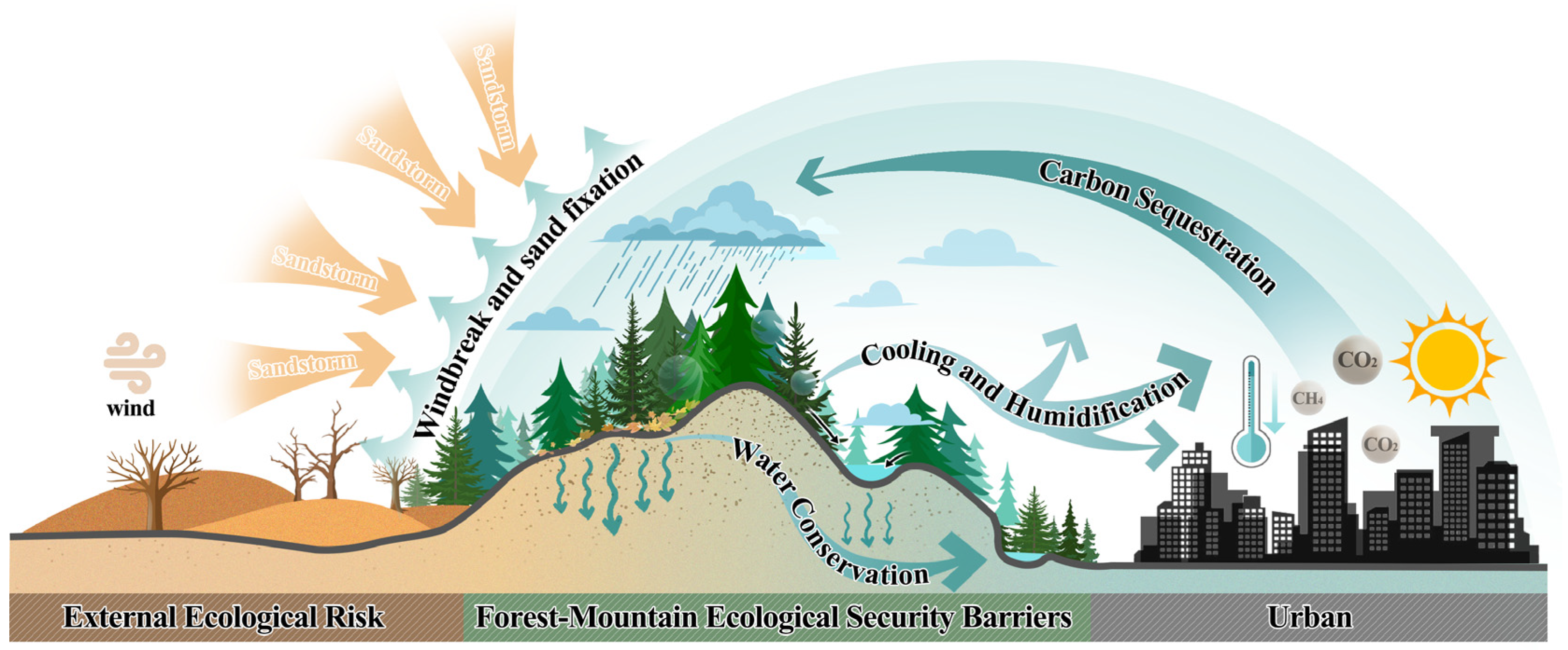

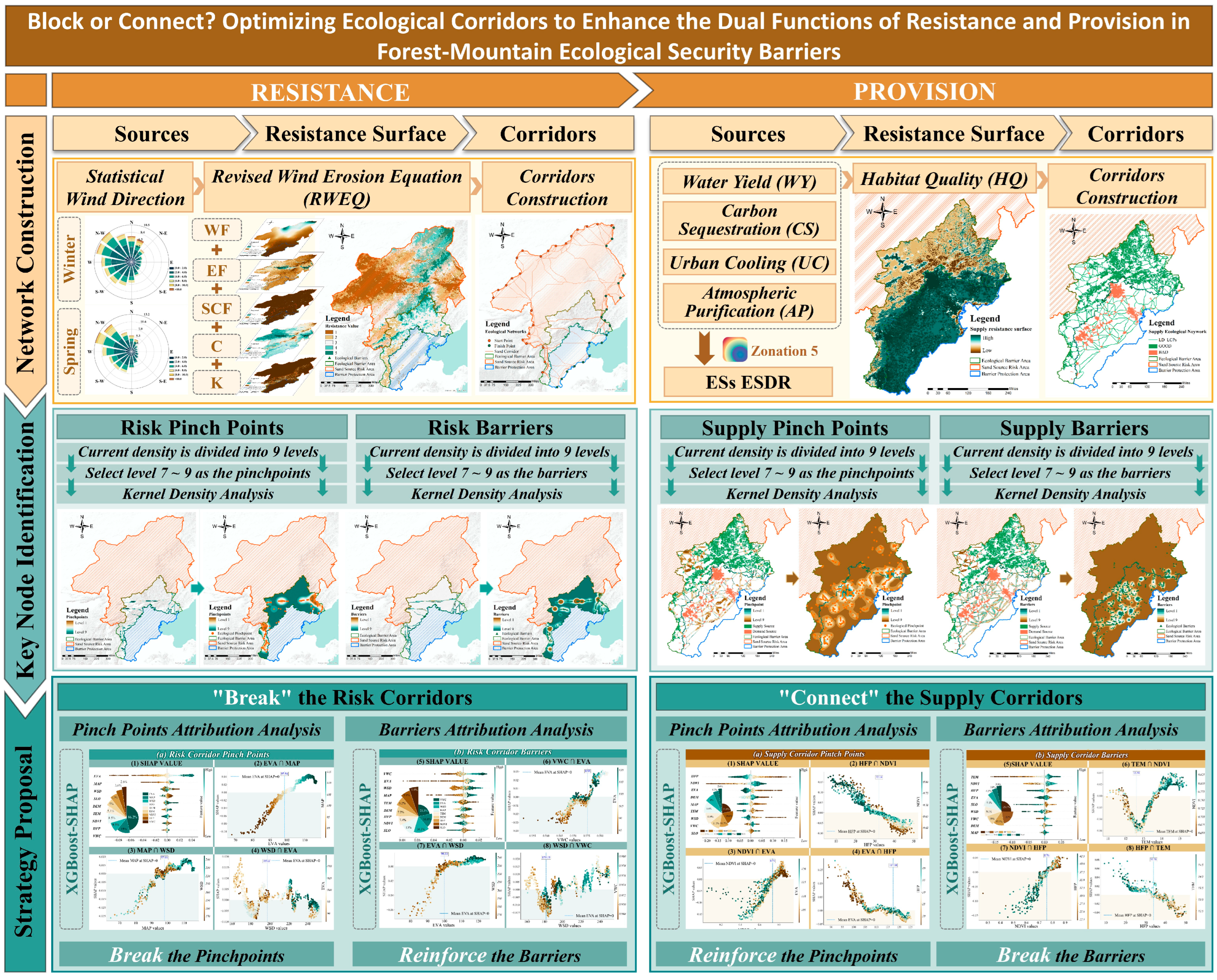
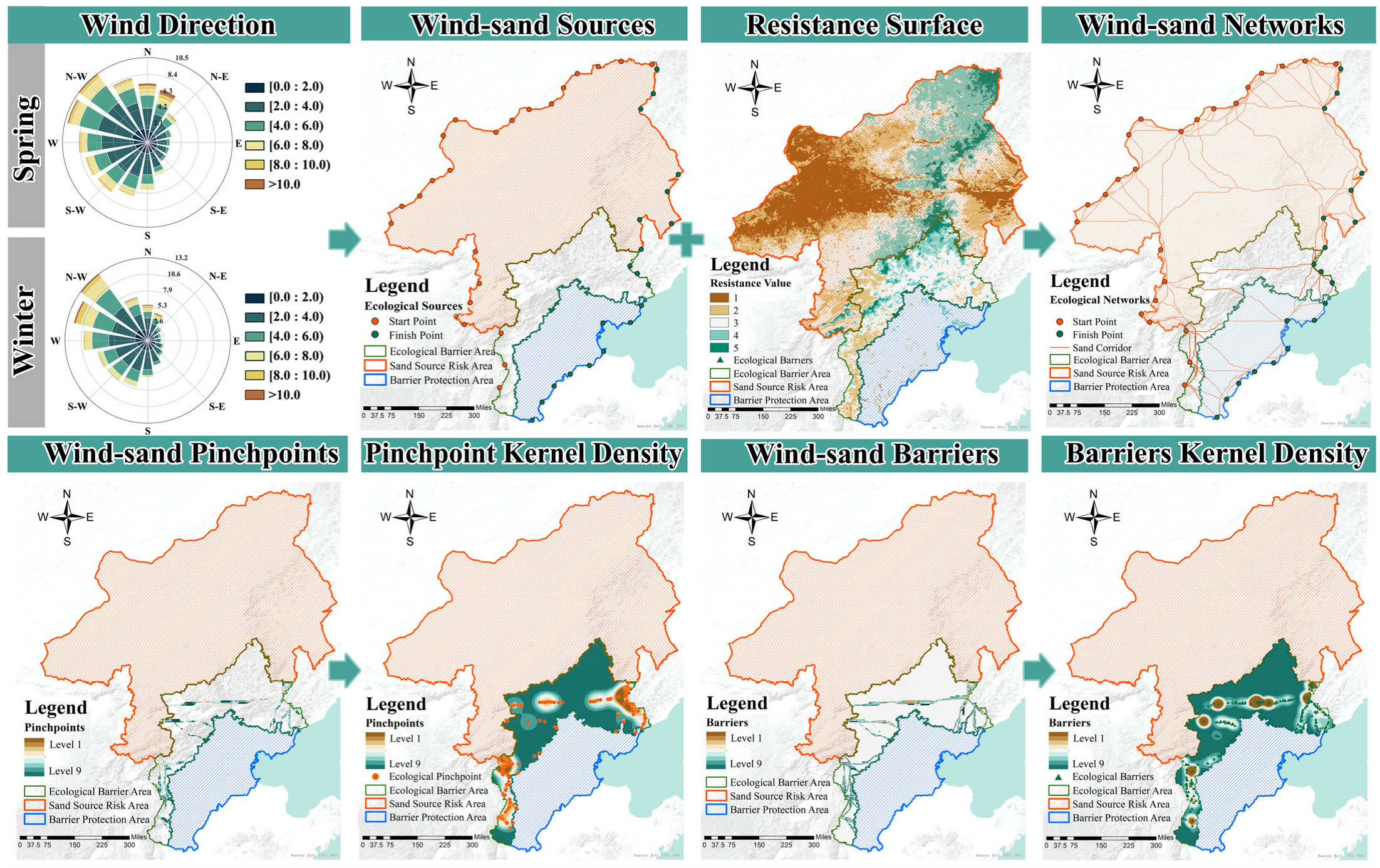
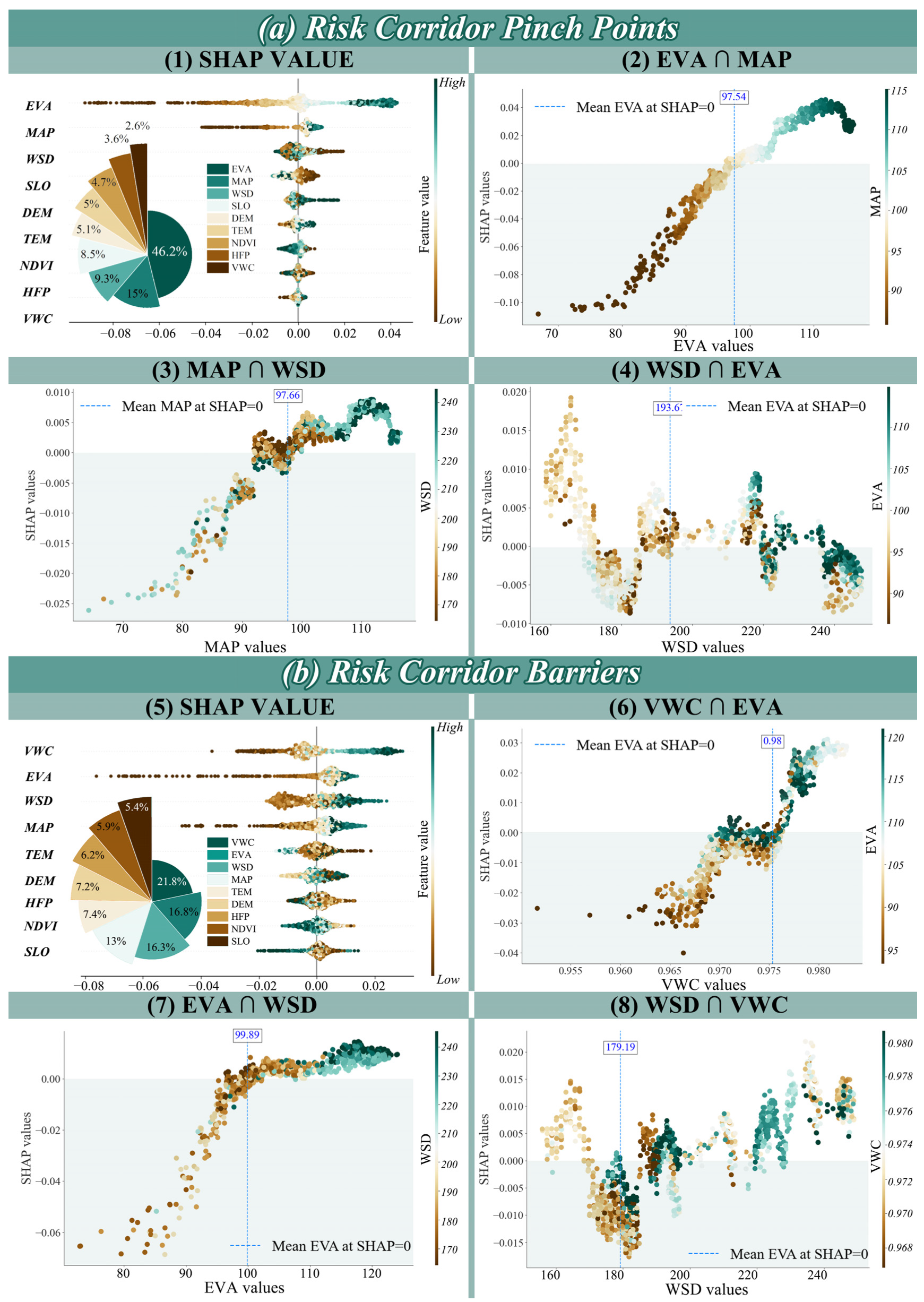

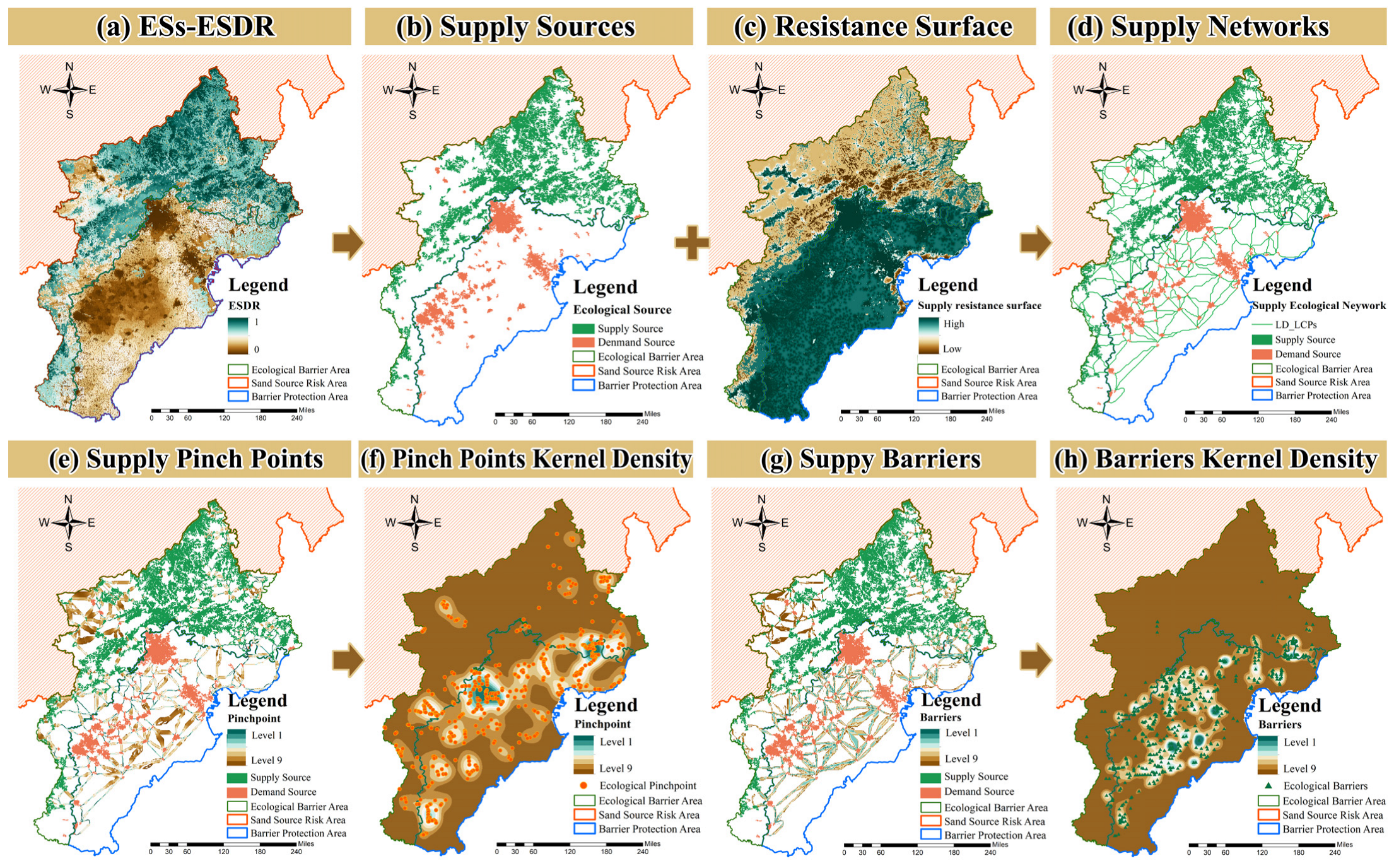

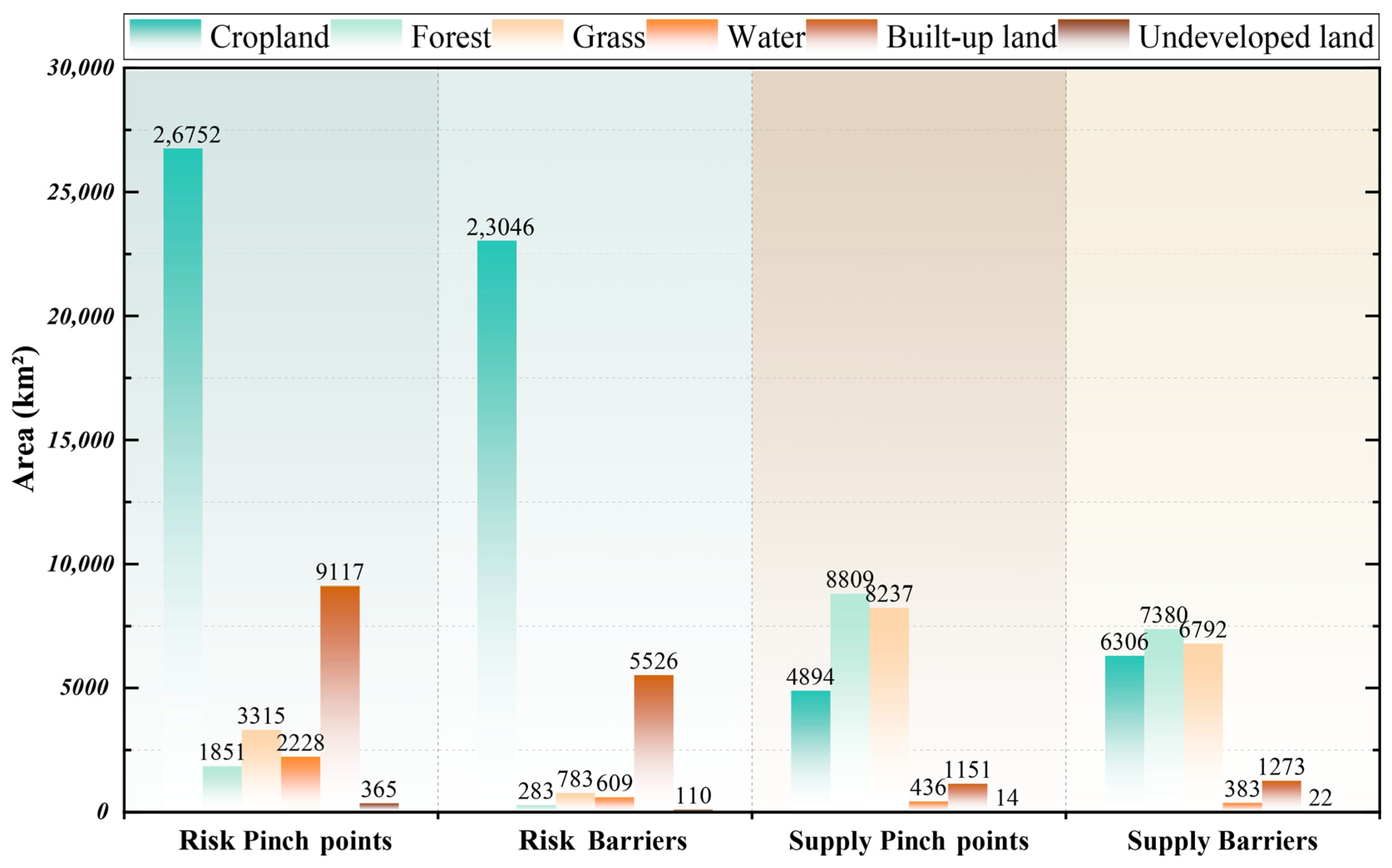
| Formulas | Marginal Notes |
|---|---|
| denotes soil wind erosion rate; represents maximum sand transport rate (kg/m); indicates critical plot length (m); signifies maximum downwind erosion distance (m); is the weather factor (kg/m); denotes surface roughness factor; denotes soil erosivity factor; denotes the soil crusting factor; denotes the FVC factor. | |
| potentially represents the maximum potential wind erosion rate; denotes the maximum potential sand transport rate (kg/m) | |
Disclaimer/Publisher’s Note: The statements, opinions and data contained in all publications are solely those of the individual author(s) and contributor(s) and not of MDPI and/or the editor(s). MDPI and/or the editor(s) disclaim responsibility for any injury to people or property resulting from any ideas, methods, instructions or products referred to in the content. |
© 2025 by the authors. Licensee MDPI, Basel, Switzerland. This article is an open access article distributed under the terms and conditions of the Creative Commons Attribution (CC BY) license (https://creativecommons.org/licenses/by/4.0/).
Share and Cite
Cao, L.; Xi, C.; Zhao, X.; Zhang, Y. Block or Connect? Optimizing Ecological Corridors to Enhance the Dual Functions of Resistance and Provision in Forest-Mountain Ecological Security Barriers. Forests 2025, 16, 1625. https://doi.org/10.3390/f16111625
Cao L, Xi C, Zhao X, Zhang Y. Block or Connect? Optimizing Ecological Corridors to Enhance the Dual Functions of Resistance and Provision in Forest-Mountain Ecological Security Barriers. Forests. 2025; 16(11):1625. https://doi.org/10.3390/f16111625
Chicago/Turabian StyleCao, Lei, Chengbin Xi, Xinyao Zhao, and Yunlu Zhang. 2025. "Block or Connect? Optimizing Ecological Corridors to Enhance the Dual Functions of Resistance and Provision in Forest-Mountain Ecological Security Barriers" Forests 16, no. 11: 1625. https://doi.org/10.3390/f16111625
APA StyleCao, L., Xi, C., Zhao, X., & Zhang, Y. (2025). Block or Connect? Optimizing Ecological Corridors to Enhance the Dual Functions of Resistance and Provision in Forest-Mountain Ecological Security Barriers. Forests, 16(11), 1625. https://doi.org/10.3390/f16111625






